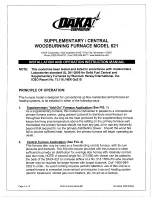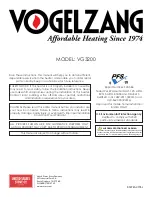
8
8390-975
Vermont Castings • Defiant® Model 1975-CAT-C Installation Manual_R8 • 02/21
In horizontal runs of unshielded chimney connector, maintain
a distance of 30" (762 mm) from the ceiling. Keep it as short
and direct as possible, with no more than two 90° turns.
Slope horizontal runs of connector upward 1/4" per foot
(6mm per meter) going from the stove toward the chimney.
The recommended maximum length of a horizontal run is 3’
(1 m), and the total length should be no longer than 8’ (2.4
m). In cathedral ceiling installations, extend the prefabricated
chimney downward to within 8’ (2.4 m) of the stove. This will
help maintain a good draft by keeping the smoke warm, so
that it rises readily.
Wear gloves and protective eyewear when drilling, cutting or
joining sections of chimney connector.
Single-wall Chimney Connectors
• Begin assembly at the flue collar of the stove. Insert the
first crimped end into the
stove’s flue collar, and keep
each crimped end pointing
toward the stove, Figure
2.3. Using the holes in the
flue collar as guides, drill
1/8" (3 mm) holes in the
bottom of the first section
of chimney connector and
secure it to the flue collar
with three #10 x 1/2" sheet
metal screws. Lift off the
griddle, and shield the
stove’s surface between
the griddle opening and the
front of the flue collar to protect the finish when you drill
the front hole.
• Fasten each joint between sections of chimney connector,
including telescoping joints, with at least three (3) sheet
metal screws. The pre-drilled holes in the top of each
section of chimney connector serve as guides when you
drill 1/8" (3 mm) holes in the bottom of the next section.
• Fasten the chimney connector to the chimney. Instructions
for various installations follow. Figure 2.4 illustrates the
general layout of chimney connector parts.
• Be sure the installed stove and chimney connector are
correct distances from nearby combustible materials.
NOTE:
Special slip pipes and thimble sleeves that form
telescoping joints between sections of chimney connector
are available to simplify installations. They often eliminate
the need to cut individual connector sections. Consult your
local dealer about these special pieces.
Figure 2.4
- An exploded view of the chimney connection in a
freestanding masonry installation.
ST242
Chimney connector
12/13/99 djt
Flue Gas
Direction
Toward
Stove
Figure 2.3
Securing the Single-wall Connector to a Prefabricated
Chimney
Follow the installation instructions of the chimney manufacturer
exactly as you install the chimney. The manufacturer of the
chimney will supply the accessories to support the chimney,
either from the roof of the house, at the ceiling of the room
where the stove is installed, or from an exterior wall.
Special adapters are available from your local dealer to
make the connection between the prefabricated chimney and
the chimney connector. The top of such adapters attaches
directly to the chimney or to the chimney’s ceiling support
package, while the bottom of the adapter is screwed to the
chimney connector.
These adapters are designed so the top end will fit outside
the inner wall of the chimney, and the bottom end will fit inside
the first section of chimney connector.
Securing the Single-wall Connector to a Masonry
Chimney
Both freestanding masonry chimneys and fireplace masonry
chimneys may be used for your installation.
Freestanding Installations
If the chimney connector must pass through a combustible
wall to reach the chimney, follow the recommendations in
the Wall Pass-Through section that follows. The opening
through the chimney wall to the flue (the
“
breech”) must
be lined with either a ceramic or metal cylinder, called the
“thimble,” which is cemented securely in place. Most chimney
breeches incorporate thimbles, but the fit must be snug and
the joint between the thimble and the chimney wall must be
cemented firmly.
ST492
Defiant
freestanding
installation
11/00
Chimney
Elbow
Slip Pipe
Standard
Connector
Oval to
Round Adapter
Flue Collar
Thimble
Flue
Inner
Flue









































